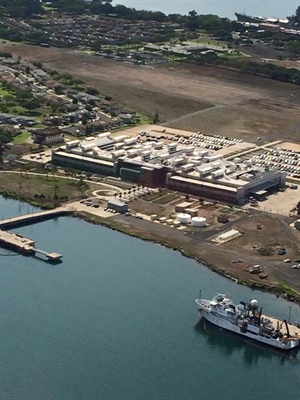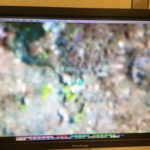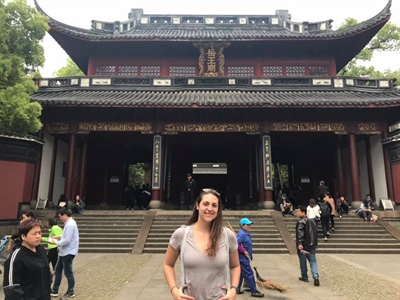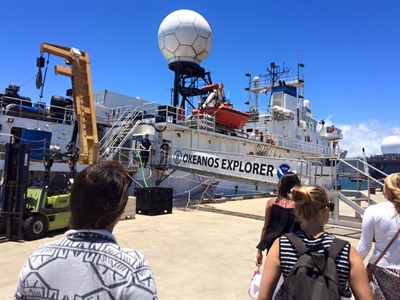Last year, North Carolina Sea Grant nominated former UNCW student Alicia Cheripka (above) for a national Knauss Fellowship. Here, she writes about what that experience has meant to her.
Growing up as an army kid, home was just wherever the military decided to stick my family, never a place I lived. But, as I was walking home from my third day as a Hollings Scholar at NOAA’s Pacific Island Fisheries Science Center (PIFSC) in Pearl Harbor, HI, it hit me that this strange new place actually “felt” like home, it was something deep in my bones. Now, I am not typically one for signs from the heavens or one to put much stock in “feelings,” but I can tell you that this moment was life altering and set me on a path to one day make it back there.

An aerial view of the NOAA’s Pacific Island Fisheries Science Center, where I worked as a Hollings Scholar.
During my NOAA Hollings internship that summer, which fell between my junior and senior years of undergrad, I worked with the benthic team at NOAA’s Coral Reef Ecosystem Division. I spent my days doing coral point count analysis to gather information about the types and amount of coral and algae coverage found on the bottom of reefs of various Pacific Islands. Was the work glamorous? No, not really. Was it groundbreaking? Not in the slightest. But to be honest, I was so much more engaged than I imagined I would be doing the ongoing monitoring and contributing data that managers could use in the real world to make decisions impacting the health of those reefs.

My ‘view’ most days as a Hollings Scholar, as I did Coral Point Count measurements.
Though I realized my passions did not lie with benthic communities, I had such an amazing time that I knew I would want to work for NOAA again, specifically back out at the Pacific Island Fisheries Science Center (PIFSC) if I could. Over the last five years, and though my path has been a lot less direct than I could have foreseen, my desire to work for NOAA again has not wavered. During my senior year at The University of South Carolina I decided to study how the expansion of an invasive species interacts with changing ocean temperatures. This area of interest landed me in a climatology lab where I was integrating parameters of lionfish life history and reproduction into physical ocean models. That short stint with models lead me to a masters project at the University of North Carolina – Wilmington modeling the use of Marine Protected Areas (MPAs) to encourage or inhibit a species shifting its range with climate change.
After spending this time in academia and realizing it might not be the right career choice for me, my old drive came back– I still wanted to work for NOAA. After graduating and applying to the Knauss fellowship (but during the long period between applying and starting the fellowship), I worked as a contractor at NOAA’s Beaufort lab in North Carolina working on their Menhaden fishery assessment. Even though there were a TON of hurdles during those months, everything from Hurricane Florence to government shut-downs, I had a great experience working on a project that had widespread applications to policy and management. It’s a good thing I enjoyed working on that project, since policy and management are now what my Knauss fellowship position focuses on!

I work with people around the world in my current position as a Knauss Fellow. Here I am in Hangzhou for my position.
As a Knauss fellow, I work… drum roll, please… for NOAA. Specifically, I work for the Ocean Acidification Program on capacity building and international policy that relates to ocean acidification (OA) and the UN Sustainable Development Goal 14.3 on OA. I had never worked on OA before, but let me tell you, this is such an exciting field! I get to be involved with a diverse group of people, from U.S. policy makers to Liberian field observers to UNESCO representatives. I have loved the experience of learning about how so many people around the globe are working together to monitor and understand the impacts OA has on the environment and local economies.

I know how important it is to enjoy the excitement of the journey.
I never thought I could love coming to work each day, and yet here I am, finally feeling like I found what I am passionate about. As much as I love this position, every once in a while I hear the distant call of those white sandy beaches in Hawai’i and know that I will return soon enough. However, I know it is best to enjoy the excitement of the journey, rather than stress about what comes next and making it to the end.
This post originally appeared on the National Sea Grant Program’s website.
##